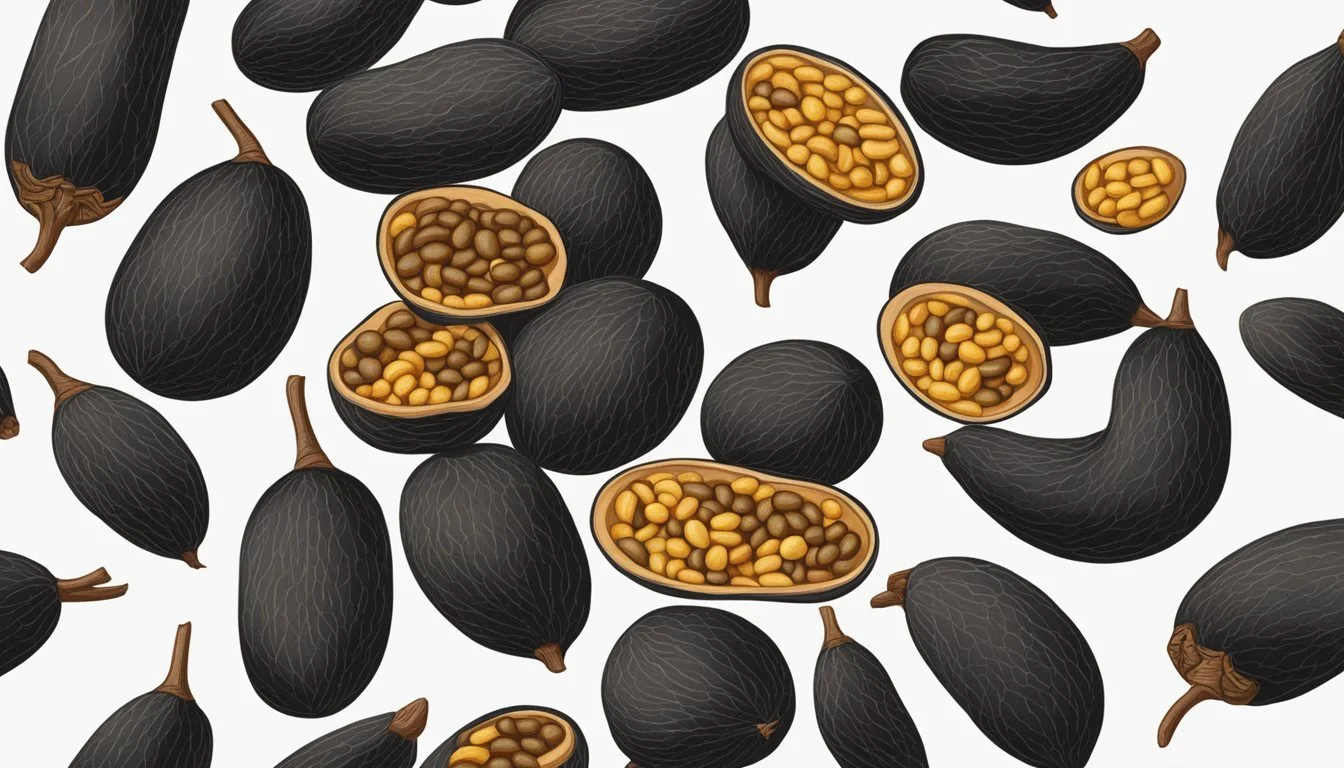Can Diabetics Eat Black Velvet Tamarind?
Nutritional Insights and Guidelines
For individuals wondering if Black velvet tamarind is suitable for those with diabetes, the answer lies within its unique nutritional profile. The fruit is low in glycemic index, meaning it causes a slower rise in blood sugar levels, making it a safer choice for diabetics. Additionally, its rich fiber content aids in blood sugar regulation, which is crucial for diabetes management.
Black velvet tamarind can be a healthy addition to a diabetic's diet due to its beneficial impact on blood glucose levels. However, moderation remains key, as excessive consumption can still lead to spikes in sugar levels. This makes it essential to balance its intake with other low-glycemic foods and monitor blood sugar levels regularly.
Combining Black velvet tamarind with a balanced diet and proper medical advice can offer diabetics a flavorful yet safe dietary option. While its health benefits are significant, it is equally important to consider personal health conditions and consult healthcare providers before making major dietary changes.
Understanding Diabetes and Dietary Considerations
Diabetes management involves careful consideration of diet, particularly focusing on how various foods impact blood sugar levels. This section explores the critical role of diet in managing diabetes and the importance of understanding carbohydrates' impact on blood glucose control.
The Role of Diet in Diabetes Management
Nutrition plays a pivotal role in diabetes management. Those with diabetes need to pay attention to their diets to maintain stable blood glucose levels. Eating a balanced diet that includes lean proteins, healthy fats, and fiber-rich foods aids in this effort.
Consuming foods with a low glycemic index (GI) can help in keeping blood sugar levels consistent. A low GI diet includes foods like whole grains, legumes, and non-starchy vegetables. Portion control is equally essential to avoid spikes in blood glucose levels.
Carbohydrates and Blood Sugar Levels
Carbohydrates are a primary energy source but can significantly influence blood glucose levels. For individuals managing diabetes, understanding the types and amounts of carbohydrates consumed is essential.
Simple carbohydrates, found in sugary foods and beverages, can cause rapid increases in blood sugar. Conversely, complex carbohydrates, present in whole grains and vegetables, are digested more slowly, leading to gradual changes in blood glucose levels.
Counting carbohydrates and monitoring their impact can assist in better insulin management, contributing to overall diabetes control. Utilizing tools like food diaries or digital apps can help in tracking carbohydrate intake and its effects on blood glucose levels.
Black Velvet Tamarind Nutritional Profile
Black velvet tamarind boasts an array of essential nutrients that offer several health benefits. This section breaks down its macronutrient content along with the vitamins and minerals it provides.
Macronutrients and Calories
Black velvet tamarind contains key macronutrients like carbohydrates, proteins, and fiber. In 100 grams of the fruit, there are approximately 2.8 grams of protein, making it a moderate source of this vital macronutrient. The carbohydrate content is significant, standing at around 63 grams per 100 grams of the fruit, which includes natural sugars.
Dietary fiber is abundant in black velvet tamarind, contributing to better digestion and prevention of constipation. Each 100 gram serving offers about 5.1 grams of fiber. This high fiber content aids in regulating blood sugar levels, an essential factor for those managing diabetes.
In terms of calories, 100 grams of black velvet tamarind provides roughly 239 calories. The natural sugars and fiber contribute to this calorie content. While it is calorie-dense, its nutrient-rich profile makes it a beneficial addition to a balanced diet.
Vitamins and Minerals Content
Black velvet tamarind is packed with an assortment of vitamins and minerals. The fruit is a notable source of vitamin C, providing about 13.8 mg per 100 grams, which plays a crucial role in boosting immunity and acting as an antioxidant. It also contains vitamin A, which supports vision and skin health.
The fruit is rich in potassium, delivering approximately 366 mg per 100 grams, which helps in maintaining healthy blood pressure levels. It also offers magnesium, calcium, and iron, each essential for various bodily functions such as bone health and oxygen transport.
In addition, black velvet tamarind contains B vitamins like thiamin (vitamin B1), riboflavin (vitamin B2), niacin (vitamin B3), and folic acid (vitamin B9). These B vitamins are important for energy metabolism and neurological health.
Finally, the presence of phosphorus ensures proper cellular function and skeleton health, making black velvet tamarind a nutritious choice for maintaining overall health.
Health Benefits of Black Velvet Tamarind
Black velvet tamarind offers several notable health benefits. It's rich in antioxidants, has anti-inflammatory properties, and supports digestive health.
Antioxidant Effects and Heart Health
Black velvet tamarind contains polyphenols and flavonoids with strong antioxidant properties. These substances combat free radicals, which can damage cells and contribute to heart disease.
Consumption of this fruit may help in reducing blood pressure and lowering bad cholesterol levels. This support for heart health is crucial, particularly for those managing chronic conditions.
Anti-inflammatory Properties
The fruit’s phytochemicals contribute to its anti-inflammatory effects. These properties can help reduce inflammation in the body, which is beneficial for those suffering from arthritis or inflammation-related conditions.
Anti-inflammatory agents in black velvet tamarind may also support immune function by reducing systemic inflammation, thus promoting overall wellness.
Digestive Health
Black velvet tamarind is beneficial for digestive health due to its high fiber content. This fiber aids in regular bowel movements and can prevent constipation.
Additionally, it helps in binding toxins from digested food, facilitating their expulsion from the body. For individuals seeking natural ways to maintain digestive health, incorporating this fruit can be advantageous.
Specific Considerations for Diabetics Consuming Black Velvet Tamarind
Black Velvet Tamarind can be consumed by diabetics with careful consideration of its glycemic index and portion control. Proper management can help mitigate potential spikes in blood sugar levels.
Glycemic Index and Blood Sugar Impact
The glycemic index (GI) of Black Velvet Tamarind remains an essential factor for diabetics to consider. GI measures how quickly carbohydrate-containing foods raise blood glucose levels. Black Velvet Tamarind, being a fruit, contains sugars that can influence blood sugar levels. Although the exact GI of Black Velvet Tamarind is not well-documented, similar fruits generally have a moderate to high GI. This implies that consumption may cause a relatively quick increase in blood glucose.
Key Nutrients:
Carbohydrates: Can raise blood sugar.
Fibre: Slows down sugar absorption.
This balance between carbohydrates and fiber should be understood by those managing diabetes to ensure consumption does not result in significant glucose spikes.
Portion Control and Frequency
Portion control is crucial for diabetics when consuming Black Velvet Tamarind. The recommended daily intake for similar tamarind varieties is about 10 grams, which should not be exceeded. Consuming small portions helps minimize the risk of hyperglycemia.
Tips for Portion Control:
Measure portions accurately.
Limit consumption to a few times per week.
Combine with low-GI foods to balance meals.
Frequency:
Frequent consumption should be avoided. Limiting intake to occasional treats ensures that the overall carbohydrate load remains manageable within a diabetic diet. Balancing with other nutrients such as protein and healthy fats can further aid in controlling blood sugar levels effectively.
Incorporating Black Velvet Tamarind into a Diabetic Diet
Black Velvet Tamarind can be beneficial for individuals with diabetes due to its low glycemic index and high fiber content. Careful attention should be paid to portion control and preparation methods to minimize any negative impact on blood sugar levels.
Recipe Ideas
Chutneys and Sauces
Black Velvet Tamarind pulp can be a tasty addition to homemade chutneys. Combine tamarind paste with spices like cumin, coriander, and chili powder. Use stevia instead of sugar to keep it diabetic-friendly. The tangy sauce pairs well with grilled chicken or fish, adding flavor without extra carbs.
Soups and Stews
Adding Black Velvet Tamarind paste to soups can enhance flavor. Use fresh tamarind in tomato-based soups or vegetable stews. The tamarind adds a unique taste and extra fiber, which helps in regulating glucose levels.
Desserts
Black Velvet Tamarind can be used to create low-sugar desserts. Mix tamarind juice with yogurt and a sugar substitute to create a refreshing treat. Portion control is crucial to ensure it remains diabetic-friendly. For instance, small tamarind panna cotta can serve as an after-dinner treat.
Marinades
Marinate lean proteins like chicken or tofu with tamarind paste, garlic, ginger, and lime juice. This makes the meat tender and flavorful without added sugars. Pair it with a side of steamed vegetables to complete the meal.
Potential Risks and Alternatives
Black velvet tamarind, due to its natural sugar content, may pose certain risks for diabetics. There are potential interactions with diabetes medications to consider, and alternative fruits and sweeteners could serve as safer options.
Interactions with Diabetes Medications
Natural sugars in black velvet tamarind can affect blood glucose levels. This impact is particularly crucial for individuals managing their diabetes through medications like insulin or metformin.
A sudden rise in blood glucose levels due to tamarind intake could lead to unpredictable results when taking these medications. Elevated blood sugar levels can alter how insulin doses are calculated, potentially making it harder to manage diabetes.
Tamarind may also have laxative effects, which could interact with the absorption of medications. This interaction could result in inadequate medication levels in the bloodstream.
Substitute Fruits and Sweeteners
For those seeking alternatives, several fruits and sweeteners can be considered. Fruits such as berries, apples, and pears provide fiber and nutrients with a lower glycemic index, making them better options for stabilizing blood sugar.
Natural sweeteners like stevia and monk fruit offer sweetness without the added sugars. These substitutes do not raise blood glucose levels, making them suitable for diabetics who need to control their sugar intake.
Additionally, using sugar-free gelatin or low-sugar yogurts can offer a sweet treat without the risk of spiking blood glucose levels. Choosing such alternatives can help maintain a balanced diet while satisfying a sweet tooth.
Culinary Uses of Black Velvet Tamarind
Black Velvet Tamarind is a versatile fruit used in various culinary applications, from traditional dishes to modern recipes. Its unique sweet and tangy flavor profile makes it a favorite ingredient in sauces, drinks, and snacks.
Traditional and Modern Usage
In traditional African cuisine, Black Velvet Tamarind is often used as a spice or seasoning. The dried fruit pulp is ground into a powder and added to soups and stews to enhance their flavor.
The fruit is also popular in making candies and snacks. Tamarind candies are a common treat, especially among children.
In modern culinary uses, tamarind is a key ingredient in exotic drinks and fusion dishes. Tamarind juice is made by soaking the pulp in water, which is then sweetened and served chilled. The unique taste of tamarind makes it a popular base for cocktails and non-alcoholic beverages.
Preparation Techniques
Preparing Black Velvet Tamarind for culinary use involves a few key techniques. The fruit is typically harvested, dried, and then either used whole or processed into pulp or powder.
Tamarind pulp is made by removing the seeds and fibers from the fruit. This pulp can be used directly in recipes or further processed into tamarind paste.
For making sauces, the pulp is simmered in water and strained to remove solids, resulting in a thick tamarind concentrate. This concentrate is often used in marinades and chutneys, providing a tangy, flavorful base for meat and vegetable dishes.
Tamarind powder, another popular form, is made by drying and grinding the fruit pulp. This powder can be sprinkled on fruit, added to sauces, or used as a spice in cooking.
These preparation techniques ensure that the unique flavor of Black Velvet Tamarind is preserved and enhances a variety of dishes.
Additional Health Considerations
Black velvet tamarind not only has potential benefits for diabetes management but is also recognized for its role in traditional medicine and exercise support, adding value to its consumption.
Tamarind in Traditional Medicine
Black velvet tamarind has been used in traditional medicine for its numerous health benefits. It contains compounds like lupeol, which has anti-bacterial and anti-fungal properties. These properties help in fighting infections.
In Ayurvedic practices, tamarind is often used to treat digestive issues, fevers, and inflammatory conditions. Consumption of tamarind is also believed to improve liver function and overall detoxification. Additionally, tamarind is a source of antioxidants such as flavonoids and polyphenols that help in reducing oxidative stress.
Exercise and Fitness Benefits
Black velvet tamarind can be a useful addition to a diet for those focusing on fitness and physical health. It's rich in fiber which aids digestion and helps in maintaining a feeling of satiety. This is beneficial for weight management.
The fruit also provides electrolytes like potassium and magnesium. These nutrients are essential for muscle function and recovery post-exercise. The presence of natural sugars in tamarind can serve as a quick energy source, making it a good option for a pre-workout snack.
People engaging in regular physical activity can benefit from the anti-inflammatory properties of tamarind, which may help reduce exercise-induced inflammation and muscle soreness.







